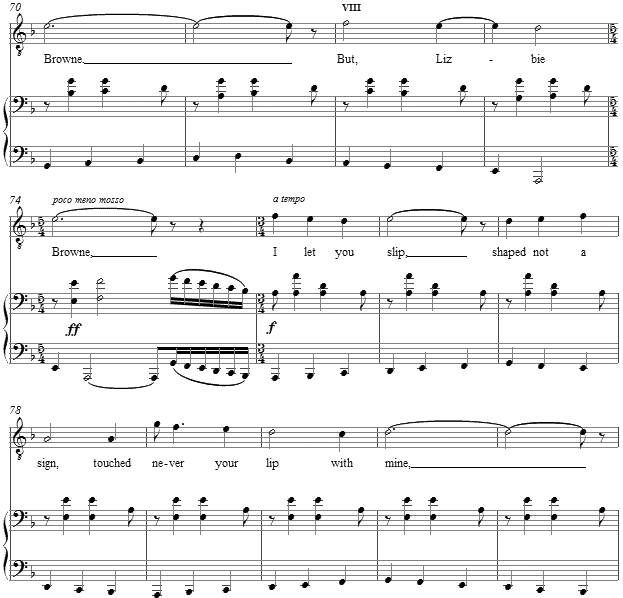Music and Texts of GARY BACHLUND
Vocal Music | Piano | Organ | Chamber Music | Orchestral | Articles and Commentary | Poems and Stories | Miscellany | FAQs
To Lizbie Browne - (2003)
Thomas Hardy
for tenor and piano
i.
Dear Lizbie Browne,
Where are you now?
In sun, in rain? -
Or is your brow
Past joy, past pain,
Dear Lizbie Browne?
ii.
Sweet Lizbie Browne,
How you could smile,
How you could sing! -
How archly wile
In glance-giving,
Sweet Lizbie Browne!
iii.
And, Lizbie Browne,
Who else had hair
Bay-red as yours,
Or flesh so fair
Bred out of doors,
Sweet Lizbie Browne?
iv.
When, Lizbie Browne,
You had just begun
To be endeared
By stealth to one,
You disappeared,
My Lizbie Browne!
v.
Ay, Lizbie Browne,
So swift your life,
And mine so slow,
You were a wife
Ere I could show
Love, Lizbie Browne.
vi.
Still, Lizbie Browne,
You won, they said,
The best of men
When you were wed….
Where went you then,
O Lizbie Browne?
vii.
Dear Lizbie Browne,
I should have thought,
'Girls ripen fast,'
And coaxed and caught
You ere you passed,
Dear Lizbie Browne!
viii.
But, Lizbie Browne,
I let you slip;
Shaped not a sign;
Touched never your lip
With lip of mine,
Lost Lizbie Browne!
ix.
So, Lizbie Browne,
When on a day
Men speak of me
As not, you'll say,
'And who was he?' -
Yes, Lizbie Browne!
[ 6 pages, circa 4'30" ]
Thomas Hardy
A shy and reclusive man, Thomas Hardy was born near in Higher Brockhampton near Dorchester in Dorset, in the southwest of England, in 1840. He studied in Dorchester and later in London, was apprenticed to an architect, and began writing only at the age of twenty-seven.
His first book was rejected by publishers and destroyed, but Far from the Madding Crowd (1874) was his first truly successful work popular with the public. After its publication he became a full-time author. With the publication of Tess of the D'Urbervilles (1891) and Jude the Obscure (1895), he gave up writing novels which he thought most people did not truly understand, but continued writing poetry, his first and last love, until his death in 1928. His work includes almost one thousand poems in eight volumes written between 1898 and 1928. His ashes are interred in the Poets' Corner of Westminster Abbey among many greats of English literature.
Originally conceived for tenor and piano, this setting of nine stanzas moves from the lower tessitura of the piano through to successive octave transpositions alongside a continuing development of the accompaniment's gestures, until a break with this "falling" motive. As the text is essentially a reflective dirge for the elusive, lost love, each entry of the opening gesture breaks out anew in a forte before subsiding into a diminuendo.
At the seventh verse, the unresolved and rhetorical questions are abandoned for his overt statement of grief and anger for not having made suit to this potential mate. His anger is, of course, with himself. For this, the opening gesture is also abandoned for a syncopated, driving "motor" gesture.
In continuing this angry self-reflection, the vocal line rises to its highest tessitura, before the last stanza settles back again into the opening dirge and a final resolution to an odd D major, decorated with E major above, after nine stanzas of resolute D minor.
The score to To Lizbie Browne is available as a free PDF download, though any major commercial performance or recording of the work is prohibited without prior arrangement with the composer. Click on the graphic below for this piano-vocal score.



